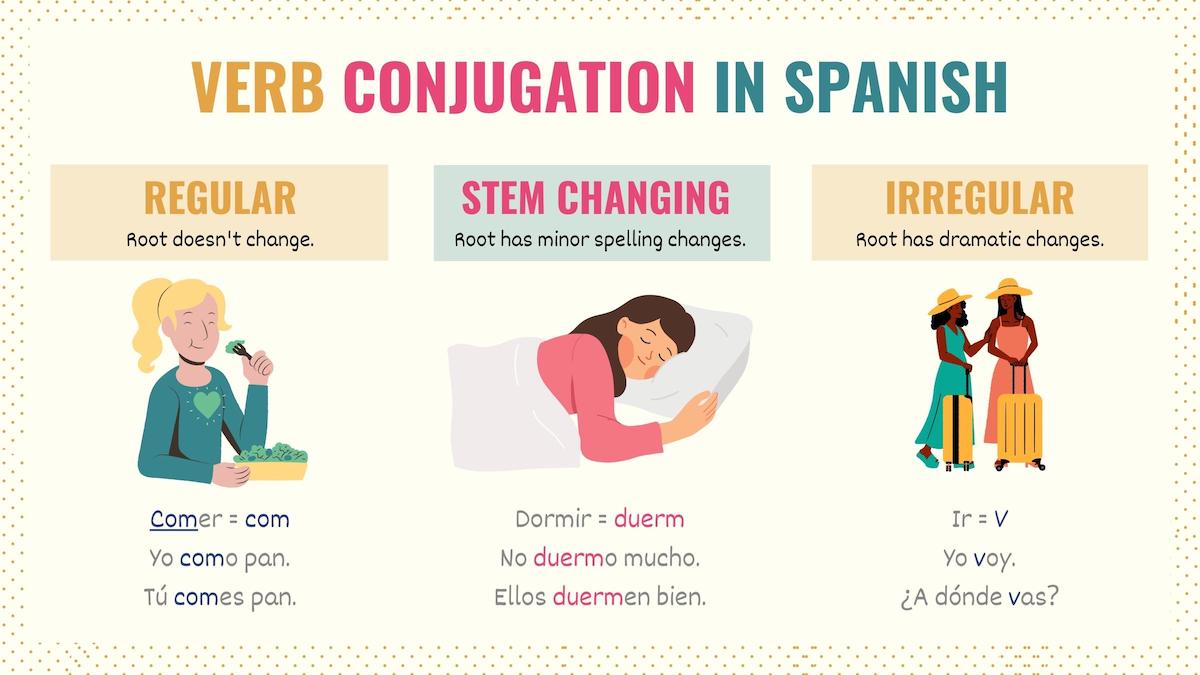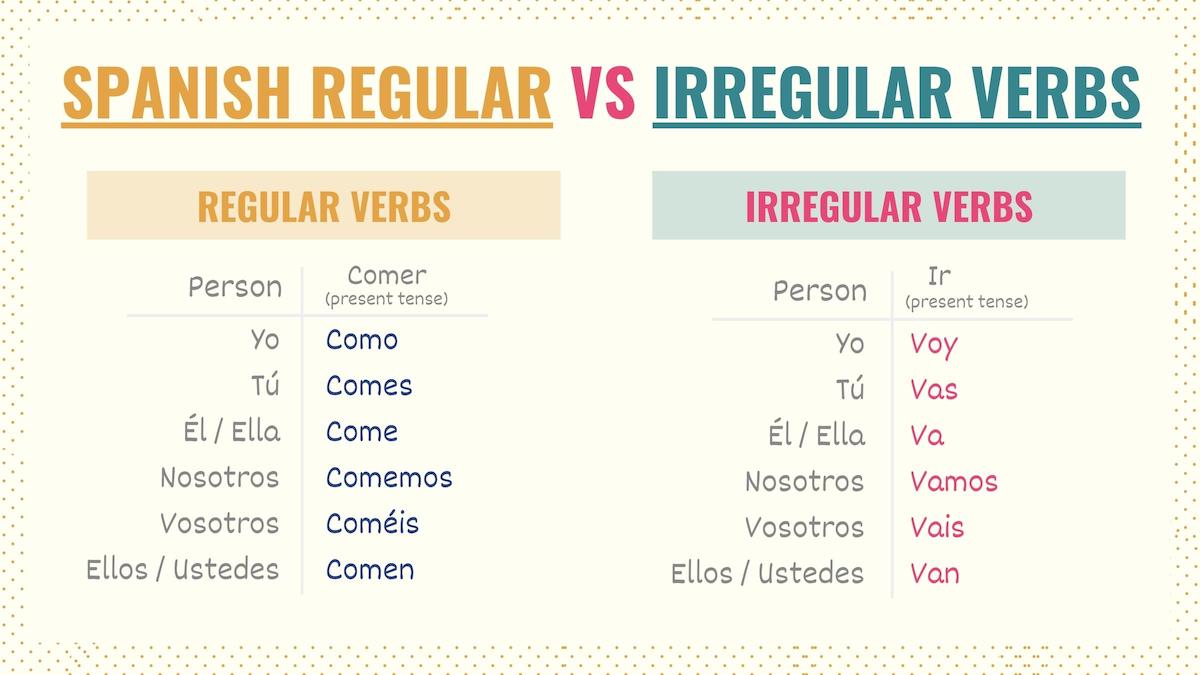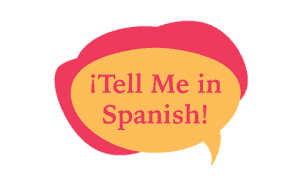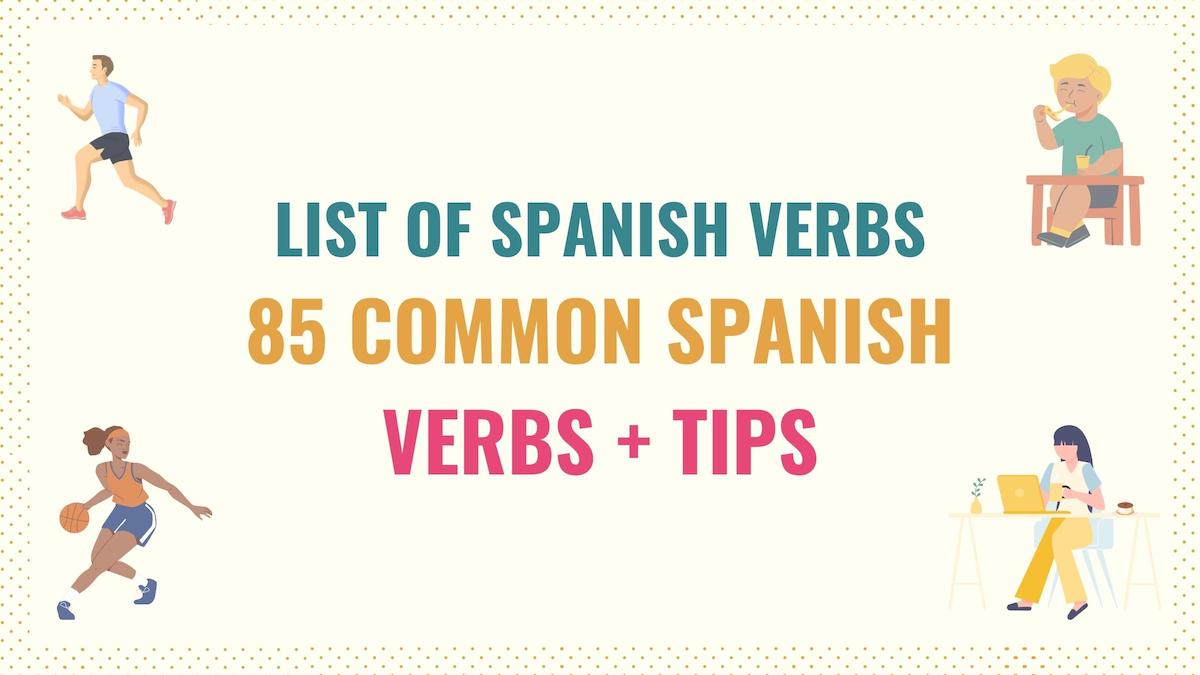A verb is the type of word that describes an action or state of being. Simply put, these words express what someone or something is doing or how that person or thing is. Since they’re essential to conversations, I’ve compiled a list of the most common Spanish verbs.
Here is a summary of what you’ll learn:
- List of Spanish Verbs: 85 Top Verbs with Conjugation Guides & Quizzes
- Starting Point: 10 Basic Verbs for Spanish Beginners to Learn
- Bonus: Learning Tips
- Additional Resources for Verbs
This guide includes a list of Spanish verbs, each with a conjugation guide and quiz so you get to practice and improve your conjugations. You can access these resources by clicking on the linked name of the verb.
List of Most Common Spanish Verbs
Although the 10 verbs you learned in the previous section are key for conversations, there are other common verbs you should add to your vocabulary.
This compilation has been classified into:
- Regular: the root doesn’t change, and we use the appropriate endings for -AR, -ER, or -IR verbs.
- Stem-changing: the root has a minor spelling change to keep the pronunciation, and then we use regular verb endings.
- Irregular: the root changes and we may use different endings.

Here is a list of Spanish verbs you should know:
Take Note: Some of these verbs may have a reflexive form to convey that the subject acts upon itself. However, not all verbs in Spanish can be reflexive.
Basic Spanish Verbs
In this section, you’ll find the key verbs for Spanish conversations. Remember to click on the link to check additional information about each verb. Be aware that the majority of verbs in this list are irregular.
What’s the difference between regular and irregular verbs?
Regular Spanish verbs have a root that remains unchanged regardless of the tense used. On the other hand, the root of an irregular verb undergoes significant changes and, in some cases, their endings may also be affected.
Because they follow a clear conjugation pattern, regular verbs are easier to learn. In the graphic below, you can see a regular vs irregular verb.

Ser – To Be
The verb ser in Spanish is used to describe people, things, and places, and to form the passive voice.
| Person | Present | Preterite |
|---|---|---|
| Yo | Soy | Fui |
| Tú | Eres | Fuiste |
| Él / EllaUsted | Es | Fue |
| Nosotros | Somos | Fuimos |
| Vosotros | Sois | Fuisteis |
| Ellos / EllasUstedes | Son | Fueron |
For example:
Norma es doctora.
Norma is a doctor.
Las vendedoras fueron muy amables.
The salespeople were very nice.
Estar – To Be
Estar is also the equivalent of the English verb ‘to be’. However, in Spanish, estar is only used to refer to location, emotional or physical states and to create the present progressive tense.
| Person | Present | Preterite |
|---|---|---|
| Yo | Estoy | Estuve |
| Tú | Estás | Estuviste |
| Él / EllaUsted | Está | Estuvo |
| Nosotros | Estamos | Estuvimos |
| Vosotros | Estáis | Estuvisteis |
| Ellos / EllasUstedes | Están | Estuvieron |
Here are some sentences:
La tienda está a dos cuadras.
The store is two blocks away.
Estuvimos ocupados todo el día.
We were busy all day.
Tener – To have
The verb tener is an irregular verb that expresses age, possession, and symptoms.
| Person | Present | Preterite |
|---|---|---|
| Yo | Tengo | Tuve |
| Tú | Tienes | Tuviste |
| Él / EllaUsted | Tiene | Tuvo |
| Nosotros | Tenemos | Tuvimos |
| Vosotros | Tenéis | Tuvisteis |
| Ellos / EllasUstedes | Tienen | Tuvieron |
For instance:
Eugenio tiene dos perros.
Eugenio has two dogs.
Lo siento, no tuve tiempo.
I’m sorry, I didn’t have time.
Take Note: Although it’s the equivalent of ‘to have’, in Spanish, tener is not used to build compound tenses. In such cases, we must use the verb haber.
Haber – To Have
In Spanish, haber is an auxiliary verb used to form compound tenses, such as the present perfect and past perfect tense.
| Person | Present | Preterite |
|---|---|---|
| Yo | He | Hube |
| Tú | Has | Hubiste |
| Él / EllaUsted | Ha | Hubo |
| Nosotros | Hemos | Hubimos |
| Vosotros | Habéis | Hubisteis |
| Ellos / EllasUstedes | Han | Hubieron |
Here is an example:
¿Has visto esta película?
Have you seen this movie?
No he comido nada.
I have not eaten anything.
Take Note: The verb haber in Spanish also has an impersonal form. Hay is used to talk about existence.
Hacer – To Do / To Make
Use hacer to talk about the activities people do or make. Keep in mind that hacer is one of the most common irregular verbs in Spanish.
| Person | Present | Preterite |
|---|---|---|
| Person | Present | Preterite |
| Yo | Hago | Hice |
| Tú | Haces | Hiciste |
| Él / EllaUsted | Hace | Hizo |
| Nosotros | Hacemos | Hicimos |
| Vosotros | Hacéis | Hicisteis |
| Ellos / EllasUstedes | Hacen | Hicieron |
Examples:
¿Qué hicieron ayer?
What did you guys do yesterday?
Elaine hace unas galletas riquísimas.
Elaine makes some delicious cookies.
Take Note: Use the impersonal form hace to talk about the weather in Spanish.
Ir – To Go
Like in English, the verb ir in Spanish conveys that a person is going somewhere. You can also use it to form the near future tense.
| Person | Present | Preterite |
|---|---|---|
| Yo | Voy | Fui |
| Tú | Vas | Fuiste |
| Él / EllaUsted | Va | Fue |
| Nosotros | Vamos | Fuimos |
| Vosotros | Vais | Fuisteis |
| Ellos / EllasUstedes | Van | Fueron |
¿A dónde fue tu mamá?
Where did your mom go?
Suzanne va a irse en unas horas.
Suzanne is leaving in a few hours.
Querer – To want
Use this verb to express things or activities you wish to do. Since it has different irregularities, you should check querer conjugation patterns.
| Person | Present | Preterite |
|---|---|---|
| Person | Present | Preterite |
| Yo | Quiero | Quise |
| Tú | Quieres | Quisiste |
| Él / EllaUsted | Quiere | Quiso |
| Nosotros | Queremos | Quisimos |
| Vosotros | Queréis | Quisisteis |
| Ellos / EllasUstedes | Quieren | Quisieron |
Here are some sentences:
¿Qué quieren hacer?
What do you guys want to do?
La niña no quiso ningún dulce.
The girl didn’t want any candies.
Gustar – To like
In Spanish, gustar is only used to talk about activities someone likes to do or to express physical attraction towards someone. Here you can check how to conjugate this verb.
| Person | Present | Preterite |
|---|---|---|
| A mí | Me gusta / gustan | Me gustó / gustaron |
| A ti | Te gusta / gustan | Te gustó / gustaron |
| A él / A ellaA usted | Le gusta / gustan | Le gustó / gustaron |
| A nosotros | Nos gusta / gustan | Nos gustó / gustaron |
| A vosotros | Os gusta / gustan | Os gustó / gustaron |
| A ellos / A ellasA ustedes | Les gustan / gustan | Les gustó / gustaron |
A Gabriel le gustan los gatos.
Gabriel likes cats.
No nos gustó la película.
We didn’t like the movie.
Take Note: In Spanish, there are other verbs like gustar that follow this conjugation pattern.
Poder – Can / To be able to
The irregular verb poder is used to talk about the activities people can or cannot do. To complete its meaning, you must use infinitive verbs.
| Person | Present | Preterite |
|---|---|---|
| Yo | Puedo | Pude |
| Tú | Puedes | Pudiste |
| Él / EllaUsted | Puede | Pudo |
| Nosotros | Podemos | Pudimos |
| Vosotros | Podéis | Pudisteis |
| Ellos / EllasUstedes | Pueden | Pudieron |
¿Puedes hablar más despacio?
Can you speak slower?
Joseph no pudo arreglar su carro.
Joseph wasn’t able to fix his car.
Dar – To give
On top of communicating that someone gives something to another person, dar in Spanish can also be used to talk about the emotions something causes in you.
| Person | Present | Preterite |
|---|---|---|
| Yo | Doy | Di |
| Tú | Das | Diste |
| Él / EllaUsted | Da | Dio |
| Nosotros | Damos | Dimos |
| Vosotros | Dais | Disteis |
| Ellos / EllasUstedes | Dan | Dieron |
Here are some examples:
Juan me dio una manzana.
Juan gave me an apple.
¿Cuánto tiempo les dieron?
How much time did they give you?
Take Note: This verb follows the same conjugation pattern as ‘gustar’ when expressing emotions’. As a transitive verb, dar works with indirect and direct object pronouns.
Bonus: Tips to Learn Verbs
Spanish verbs are crucial because they allow you to explain what the action is. Here are some easy tips you can follow to learn this type of vocabulary:
- Focus on key verbs for your conversations: Instead of trying to memorize as many words as possible, you should take the time to choose verbs that you will likely use daily. The verbs in this article are a good starting point because they relate to common situations.
- Practice: If you learn a new verb, you must practice it as much as possible. Ideally, you should try to include it in your conversations. However, you can also write sentences in different tenses, use flashcards, or practice their conjugation.
- Learn opposite verbs: This is what I call the Opposite Method and the idea is very simple. Our brain is very good at thinking in opposites (blanco, negro, arriba, abajo). So, when you learn a verb, take the time to learn its antonym because you’re likely going to need it – Prende la luz y apágala cuando termines. Finding these connections can make your learning process more significant.
Extra Resources to Master Verbs in Spanish
Now that you know the most common verbs in Spanish, here are your next steps.
- Guide to Spanish Verb Conjugation: Compared to English, Spanish conjugation can be more challenging because each subject has a different ending in each tense. So, make sure you understand how to conjugate verbs.
- Verb Forms in Spanish: If you understand the steps to conjugate verbs, you can check what regular endings you’re supposed to use in each Spanish tense.
- Conjugation models: The ending of an infinitive verb establishes the conjugation you must follow. To learn more about these conjugation patterns, you should check:
- Irregular Verbs Guide: Find more information about irregulars and some tips to conjugate these verbs.
- Stem-changing Verbs: There are more stem-changing verbs than irregulars. In this guide, you’ll find the most common spelling changes in Spanish.
- Types of Verbs: In Spanish, a verb can play different roles inside of a sentence or may work with different elements. Understanding different types of verbs will help you use these words more effectively.
- Spanish Moods: A Spanish verb also conveys how an action is perceived. Using the imperative, indicative, or subjunctive mood will change what you say. So, take the time to understand how moods in Spanish work.
Download the PDF with the Most Common Verbs in Spanish
Now that you’ve learned the most common Spanish verbs that beginners need to master to become fluent in Spanish, you know that you’ll probably need a refresher. Click the button below to download a copy of the PDF for this guide. It contains the list verbs above as well as the fundamentals of Spanish verb conjugation.



